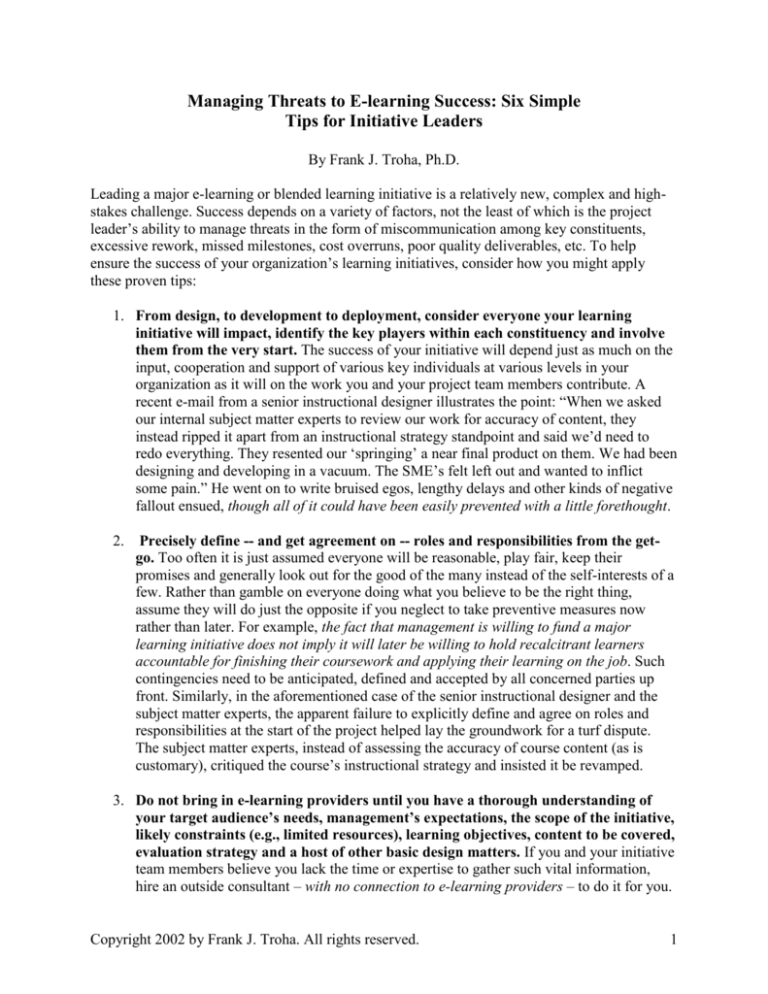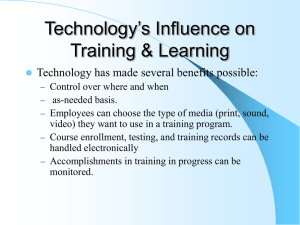
Managing Threats to E-learning Success: Six Simple
Tips for Initiative Leaders
By Frank J. Troha, Ph.D.
Leading a major e-learning or blended learning initiative is a relatively new, complex and highstakes challenge. Success depends on a variety of factors, not the least of which is the project
leader’s ability to manage threats in the form of miscommunication among key constituents,
excessive rework, missed milestones, cost overruns, poor quality deliverables, etc. To help
ensure the success of your organization’s learning initiatives, consider how you might apply
these proven tips:
1. From design, to development to deployment, consider everyone your learning
initiative will impact, identify the key players within each constituency and involve
them from the very start. The success of your initiative will depend just as much on the
input, cooperation and support of various key individuals at various levels in your
organization as it will on the work you and your project team members contribute. A
recent e-mail from a senior instructional designer illustrates the point: “When we asked
our internal subject matter experts to review our work for accuracy of content, they
instead ripped it apart from an instructional strategy standpoint and said we’d need to
redo everything. They resented our ‘springing’ a near final product on them. We had been
designing and developing in a vacuum. The SME’s felt left out and wanted to inflict
some pain.” He went on to write bruised egos, lengthy delays and other kinds of negative
fallout ensued, though all of it could have been easily prevented with a little forethought.
2. Precisely define -- and get agreement on -- roles and responsibilities from the getgo. Too often it is just assumed everyone will be reasonable, play fair, keep their
promises and generally look out for the good of the many instead of the self-interests of a
few. Rather than gamble on everyone doing what you believe to be the right thing,
assume they will do just the opposite if you neglect to take preventive measures now
rather than later. For example, the fact that management is willing to fund a major
learning initiative does not imply it will later be willing to hold recalcitrant learners
accountable for finishing their coursework and applying their learning on the job. Such
contingencies need to be anticipated, defined and accepted by all concerned parties up
front. Similarly, in the aforementioned case of the senior instructional designer and the
subject matter experts, the apparent failure to explicitly define and agree on roles and
responsibilities at the start of the project helped lay the groundwork for a turf dispute.
The subject matter experts, instead of assessing the accuracy of course content (as is
customary), critiqued the course’s instructional strategy and insisted it be revamped.
3. Do not bring in e-learning providers until you have a thorough understanding of
your target audience’s needs, management’s expectations, the scope of the initiative,
likely constraints (e.g., limited resources), learning objectives, content to be covered,
evaluation strategy and a host of other basic design matters. If you and your initiative
team members believe you lack the time or expertise to gather such vital information,
hire an outside consultant – with no connection to e-learning providers – to do it for you.
Copyright 2002 by Frank J. Troha. All rights reserved.
1
Similarly, if you and your team lack instructional design skills, hire a competent,
independent ID consultant who can help you scope out a preliminary design document
(see Figure 1: Main Components of an Instructional Design Document). The rationale for
doing so cannot be overstated. Until you -- and all other internal key players -- are at least
generally agreed on where you need to end up, where you are now, what resources you
have and what resources (from both inside and outside of the organization) you will
likely need, you are in no position to intelligently communicate your organization’s needs
and desires to prospective e-learning providers, much less speak on behalf of your
constituents.
4. Carefully select the right provider for the job. Buying e-learning or blended learning
services is fraught with challenges. To improve the odds of choosing the most appropriate
provider, consider the following guidelines.
a. Develop and confirm precise, comprehensive selection criteria (e.g., past
experience addressing similar topics for similar organizations, fee
structure, service standards, references, etc.) before meeting with any
prospective providers. Without such internally developed and approved
criteria, you are likely to wind up comparing apples with oranges.
Additionally, unless key internal stakeholders are involved in setting and
approving the selection criteria you will use, you may – come hiring time –
encounter resistance to the provider you favor.
b. Use the preliminary design document and selection criteria to interview
prospective providers. The preliminary design document should enable you
to clearly and efficiently communicate what you have in mind to prospective
providers as well as respond informatively to any questions they ask you.
Further, the document should position you to pose this crucial question to
potential providers: To take our design to the next level, what exactly would
you recommend and why? The prepared selection criteria would prompt other
important questions, such as: How long would it take your organization to
deliver what we need? How much would it cost? What might cause the price
to exceed that figure? What guarantees can you provide in terms of our
satisfaction with the quality of your work and client service? Will you prepare
– at no cost to us -- a sample unit or lesson, to demonstrate what you would
do for us? If you are awarded the project, how do you see us collaborating
during design, development and deployment? By virtue of applying the agreed
upon preliminary design document and selection criteria, you and everyone
else involved in the selection process can compare apples with apples and
base your choice of provider on an objective, internally-accepted scorecard.
c. If you are new to e-learning or blended learning, start small. According to
Forrester Research (www.forrester.com), only 30% of employees bother to
complete an e-learning course. With statistics like that (and others that are
equally worrisome), it is not only wise to choose outside help carefully, it is
Copyright 2002 by Frank J. Troha. All rights reserved.
2
imperative that you limit your initial financial commitment to a small
initiative or a portion of a larger one.
5. From start to finish, keep all key individuals informed and appropriately involved.
A successful e-learning or blended learning initiative requires careful project planning,
solid instructional design, the development of all instructional components based on an
approved design document, ongoing attention to project management issues (e.g., budget,
scheduling and communications), various formative evaluations prior to launch,
deployment of the learning and ongoing evaluation and maintenance of the learning
system. With so many activities affecting so many people, you simply cannot afford to
neglect ongoing communication with all key players throughout the process. But, doesn’t
such communication open a Pandora’s box of questioning, second-guessing and time
consuming follow-up? Ironically, failing to communicate regularly is more likely to delay
progress – or much worse. A couple of noses out of joint over being left out of the loop
has been known to foment a crisis. Worth noting is the fact that precisely defining and
agreeing to roles and responsibilities up front helps to preempt a significant, if not
substantial, number of queries later on.
6. Strive for self-sufficiency and control. Though live, instructor-facilitated, face-to-face
classroom instruction will not likely be replaced by e-learning, rest assured e-learning is
here to stay. As you gain experience with e-learning and blended learning, consider
bringing as much of the total effort as practicable in-house. Besides saving money, you
will become less dependent on the efforts of outside providers who have much less of a
stake than you in the success of your initiatives and their impact on your career. Already
some of today’s Learning Content Management Systems make updating existing ecourses a snap for anyone who cares to invest a few minutes in learning how to do so.
Further, most in-house training personnel are capable of preparing preliminary designs
for e-learning and blended learning courses. By virtue of producing a design in-house, the
involvement (and cost) of an outside design consultant can be limited to providing
feedback on the preliminary design and enhancing its overall effectiveness. (For a free
report detailing how to independently produce preliminary designs for e-learning and
blended learning courses, send your request to: frank@franktroha.com.)
Perhaps you have personally experienced some of the many threats that plague major e-learning
and blended learning initiatives. If so, I think you would agree upon reflection that all such
threats can be successfully prevented or mitigated. Foresight, diligence and know-how, including
the application of the six simple tips shared here, are all key to initiative success and well worth
your time and effort.
Frank J. Troha, Ph.D., is an independent e-learning and blended learning design consultant,
assisting a wide variety of U.S. corporations. For information about his background and advisory
services, write to: frank@franktroha.com.
Copyright 2002 by Frank J. Troha. All rights reserved.
3
Figure 1: Main Components of an Instructional Design Document
1. Course Title
2. Purpose Statement
3. Audience Description
4. Duration
5. Prerequisites (if any)
6. Learning Objectives
7. Constraints
8. Content / Learning Activities Outline (For each item of content to be addressed, indicate
how it would be conveyed to audience members and the estimated time required.)
9. Transfer of Learning Strategy
10. Evaluation Strategy
11. Content Sourcing (What We Have vs. What We Need)
Add any other sections that are needed to clearly and comprehensively communicate your
design, including all project management documentation.
- end -
Copyright 2002 by Frank J. Troha. All rights reserved.
4






